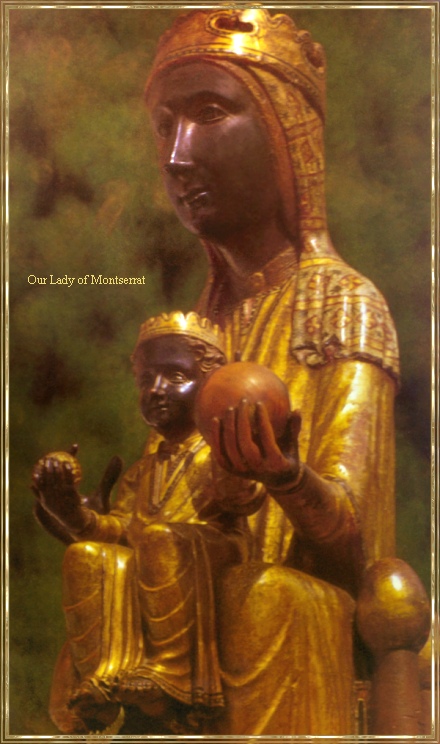Saint Ignatius Loyola constantly wore an image of the Sorrowful Mother on his bosom, and venerated her with tender devotion.
"Mary's sorrow was less when she saw her only Son crucified, than it is now at the sight of men offending Him by sin."- St.Ignatius of Loyola
http://www.catholictradition.org/Mary/sorrows1a.htm

Sanctuary of Loyola, in Azpeitia, built over St. Ignatius' birthplace in Spain. http://www.ignatiusofloyola.net/
Ignatius had his conversion vision of Mary in a Hospital near the family castle in Loyola.
Vision of Mary (diorama)1521T
The great Spanish knight Ignatius of Loyola underwent a spectacular conversion to God while he was recuperating from wounds received in battle. http://iveignatianexercises.org/site/dbpage.asp?page_id=180000188&sec_id=180000384
 http://www.xavier.edu/jesuitresource/jesuit-a-z/Mary,-the-Hidden-Catalyst-Reflections-from-an-Ignatian-Pilgrimage-to-Spain-and-Rome.cfm
http://www.xavier.edu/jesuitresource/jesuit-a-z/Mary,-the-Hidden-Catalyst-Reflections-from-an-Ignatian-Pilgrimage-to-Spain-and-Rome.cfmRecuperating from war wound
"He saw clearly a likeness of Our Lady with the Holy Child Jesus... (from which) he received a very extraordinary consolation."
Eventually, completely converted from his old desires and plans of romance and worldly conquests, and recovered from his wounds enough to travel, he left Loyola in March of 1522.
He had decided to go to Jerusalem to live where our Lord had spent His life on earth. His journey led him first to Barcelona. He first proceeded to the Benedictine shrine of Our Lady of Montserrat, made a general confession, and knelt all night in vigil before Our Lady's altar, following the rites of chivalry. He left his sword and knife at the altar, went out and gave away all his fine clothes to a poor man, and dressed himself in rough clothes with sandals and a staff.


http://www.catholictradition.org/ignatius.htm http://en.wikipedia.org/wiki/Virgin_of_Montserrat
The miraculous statue of the Black Madonna (La Moreneta) the Shrine of Our Lady of Montserrat.
Since the 12th century, pilgrims have been drawn to the mountain to venerate this image.The thirty-eight inch statue shows evidence of Byzantine conventional and stylized form, and is painted in polychrome. The art historical designation for this type of pose is called "Throne of Wisdom". The body is thin, the face elongated. She holds an orb of the earth in her right hand. The Child's hand is raised in a formalized and traditional Eastern blessing
MANRESA
He continued on to Barcelona, stopping along the river Cardoner at a town called Manresa. He stayed in a cave outside the town, intending to linger only a few days, but he remained for ten months. He spent hours each day in prayer and also worked in a hospice. It was while here that the ideas for what are now known as the Spiritual Exercises began to take shape.
At Manresa God treated Ignatius as a schoolboy and stamped indelible mystical visions of the Trinity and Jesus’ humanity and Jesus’ presence in the Eucharist into Ignatius.

Ignatius writing the Spiritual Exercises in the cave at Manresa with the Manresa bridge and the Montserrat mountains in the background.
http://www.xavier.edu/jesuitresource/jesuit-a-z/Mary,-the-Hidden-Catalyst-Reflections-from-an-Ignatian-Pilgrimage-to-Spain-and-Rome.cfm
He spent part of 1523 and 1524 in the Holy Land.
Ignatius went to Paris to study. During these student days Ignatius gathered a body of mystical men around him who were united by love of Christ and each other.On August 15th 1534 in Paris, Ignatius and his first companions took private vows of poverty and chastity.
http://norprov.org/spirituality/lifeofignatius.htm
It was also in Paris that he began sharing a room with Francis Xavier and Peter Faber. He greatly influenced a few other fellow students (Xavier was the hardest nut to crack, interested as he was mainly in worldly success and honors), directing them all at one time or another for thirty days in what we now call the Spiritual Exercises.
On June 24th1537 Ignatius and other companions were ordained though they did not celebrate their First Mass for a long time afterwards. During his time preparing for priesthood he received many spiritual visions and supernatural visitations and deep assurances from God about certain matters.

St. Ignatius,Vision at the Chapel of La Storta
Icon by William McNichols.http://puffin.creighton.edu/jesuit/andre/ignatius_trinity.html
Ignatius, along with two of his companions, Peter Faber and James Lainez, decided to go to Rome and place themselves at the disposal of the Pope. It was a few miles outside of the city that Ignatius had the second most significant of his mystical experiences. At a chapel at La Storta where they had stopped to pray, God the Father told Ignatius, "I will be favorable to you in Rome" and that He would place him (Ignatius) with His Son.In the Basilica of Santa Maria Maggiore in Rome during Christmas 1538 he celebrated his First Mass. In Rome he taught the Spiritual Exercises. During his time in Rome his mystical life reached its maturity.
Madonna Della Strada or Santa Maria Della Strada — the Italian for Our Lady of the Way, or Our Lady of the Road — is the name of a late 15th or 16th century image of the Blessed Virgin Mary.This was the image before which Ignatius prayed at the church of Our Lady of the Way in Rome. It is now in the Church of the Gesù. The feast of Our Lady of the Way (24th May) was restored to the Jesuit liturgical calendar in 2014.
Basilica di Santa Maria Maggiore (Rome) - statue of the Holy Mary 'Ave Regina Pacis'
http://commons.wikimedia.org/wiki/File:SM_Maggiore,_Roma_fc06.jpg

No comments:
Post a Comment